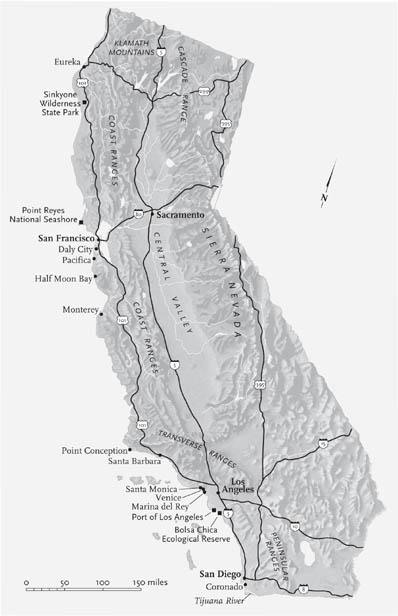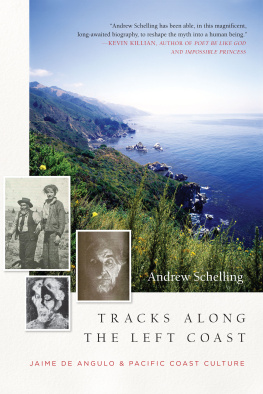The publisher gratefully acknowledges the generous support of the August and Susan Frug Endowment Fund in California Natural History of the University of California Press Foundation.
The publisher also gratefully acknowledges the generous support of the Directors Circle of the University of California Press Foundation, whose members are:
Anonymous
Wendy Ashmore
Janelle Cavanagh & Dominic Walshe
Earl & June Cheit
Charles R. & Mary Anne Cooper
Lloyd Cotsen
John & Jo De Luca
Sukey & Gilbert Garcetti / Roth Family Foundation
Walter S. Gibson
Harriett & Richard Gold
Prof. Mary-Jo DelVecchio Good & Prof. Byron Good
Gary K. Hart
Monica Heredia
Patricia & Robin Klaus
Watson M. & Sita Laetsch
Dr. Mary Gibbons Landor
David Littlejohn
Robert & Beverly Middlekauff
Lucinda Reinold
Lisa See & Richard Kendall
Ruth A. Solie
Judy & Bill Timken
In memoriam, the UC Press Foundation gratefully acknowledges the dedication and support of Diana P. Scott.
THE LEFT COAST

THE LEFT COAST
CALIFORNIA ON THE EDGE
PHOTOS BY ALEX L. FRADKIN + TEXT BY PHILIP L. FRADKIN

University of California Press, one of the most distinguished university presses in the United States, enriches lives around the world by advancing scholarship in the humanities, social sciences, and natural sciences. Its activities are supported by the UC Press Foundation and by philanthropic contributions from individuals and institutions. For more information, visit www.ucpress.edu .
University of California Press
Berkeley and Los Angeles, California
University of California Press, Ltd.
London, England
2011 Alex L. Fradkin and Philip L. Fradkin
Library of Congress Cataloging-in-Publication Data
Fradkin, Philip L.
The left coast : California on the edge / text by Philip L.
Fradkin ; photos by Alex L. Fradkin.
p. cm.
Includes bibliographical references and index.
ISBN 978-0-520-25509-8 (pbk. : alk. paper)
1. CaliforniaDescription and travel. 2. CoastsCalifornia. 3. CaliforniaHistory. 4. Natural historyCalifornia. 5. Fradkin, Philip L.TravelCalifornia. 6. Fradkin, Alex (Alex Leon), 1966TravelCalifornia. I. Fradkin, Alex (Alex Leon), 1966. II. Title.
F866.2.F725 2011
979.4dc22 2010035056
Manufactured in China
20 19 18 17 16 15 14 13 12 11
10 9 8 7 6 5 4 3 2 1
The paper used in this publication meets the minimum requirements of ANSI/NISO Z39.481992 (R 1997) (Permanence of Paper).
To Dad, for the first time
For Alex, again

CONTENTS
PROLOGUE
Until I began working on this book, I didnt realize to what extent I was an aqueous person. True, Im a Pisces, but by aqueous I mean Im intensely drawn to salt water. Freshwater just wont do it. Its too thin. It knifes through my nostrils like cold air, leaving a momentary sting. Salt water is thick and pungent with the smells of distant continents and a blended decay that bespeaks an abundance of life-forms. There have been just a few yearsI view them as involuntary exilewhen I havent lived, worked, or played near salt water, whether on the south shore of Long Island in New York State or in the coastal counties of Marin and Los Angeles in California.
Language and physical features separate the two edges of the continent. In the East it is the shore, meaning the Jersey shore or the north and south shores of Long Island. Shore is a sibilant word that fits long, flat stretches of sandy beaches lapped by soft, hissing surf. In eastern publications, the Coast is a synonym for the western edge of the continent and an ambiguous portion of the whole state. The abruptness of the word matches the steep bluffs and rocky headlands that provide so much drama in Northern California. South of Point Conception, the more prevalent use of the word beach indicates a softening of the interface between salt water and land in Southern California. Orientation to a map provides yet another viewpoint, with its own set of echoes. Left, as in The Left Coast, denotes someone or something that is different, strange, a bit noir, or liberal.
As for my attraction to and the magnetic pull of salt water upon me, the facile explanation is the astrological sign under which I was born. For some people that explanation will suffice. For the more seriously inclined, there is no easy explanation, other than what may be known about inherited characteristics and early influences of a landscape upon an individual. Deserts, mountains, valleys, canyons, and prairies affect others in similar ways. Actually, all those places in the American West draw me, but none as powerfully as the coast.
In my search for the essence of the California coast and a suitable description for others who may not be as deeply involved in it as I have been for the last fifty years, I have divided the coastline according to eight major uses or activities and assigned them chapters. For each function I have selected an emblematic place to illustrate it. The eight coasts of California and the places whose particular uses I have chosen to describe are The Wild Coast (Sinkyone Wilderness), The Agricultural Coast (western Marin County), The Residential Coast (Daly City, Pacifica, Half Moon Bay), The Tourist Coast (Monterey), The Recreational Coast (Santa Monica, Venice, Marina del Rey), The Industrial Coast (Port of Los Angeles), and The Military Coast (San Diego). The Political Coast (Bolsa Chica Ecological Reserve) is an example of how a law and its political implementation have shaped the continents western edge.
The quotes at the beginning of each chapter provide insights of others from the past, thus contributing to and deepening the inquiry. The photographs illustrate the different activities but range more widely than my descriptions to give the subject a greater geographic and interpretive reach. Combined, the words and images not only define the coast, but they also go a long way toward explaining California. The coast, in many ways, is California, for most of the states population lives within its narrow strip.
I am not a disinterested observer. My memories are included in this account because they explain my interest in coastal matters, contain some history, and form a cycle dating back to my first book, California: The Golden Coast, published in 1974. They also provide a human perspective by describing, in part, a father-son relationship. My then-young son, Alex, accompanied me on my research trips for that book. My now-middle-aged son took the photographs for this book and did much of the driving. The first coast book was dedicated to him, as is this bookthus the cycle is completed as I approach old age. We are partners in this second coastal venture, the only difference being our means of expression and the specific tools we use to communicate our messages. I think we are fairly close in terms of tone and intent.
The reader will notice that the photographs dont follow the structural device I chose to portray the coast. We began this project thinking there should be a close relationship, and then we both felt constrained by the artificiality of tying the photos directly to the text. The images range geographically and topically further from, but still relate to, the eight categories. They flow more freely in accordance with their greater artistic expressiveness that demanded their own associative arrangements. We believe the book comes closer than any previous work to capturing the shadings and extremes of coastal complexities. We have done this by combining personal, historic, journalistic, autobiographical, and artistic components into both a literal and an emblematic document. (Alex has more to say about his photographs in his essay at the end of this book.)
Next page







